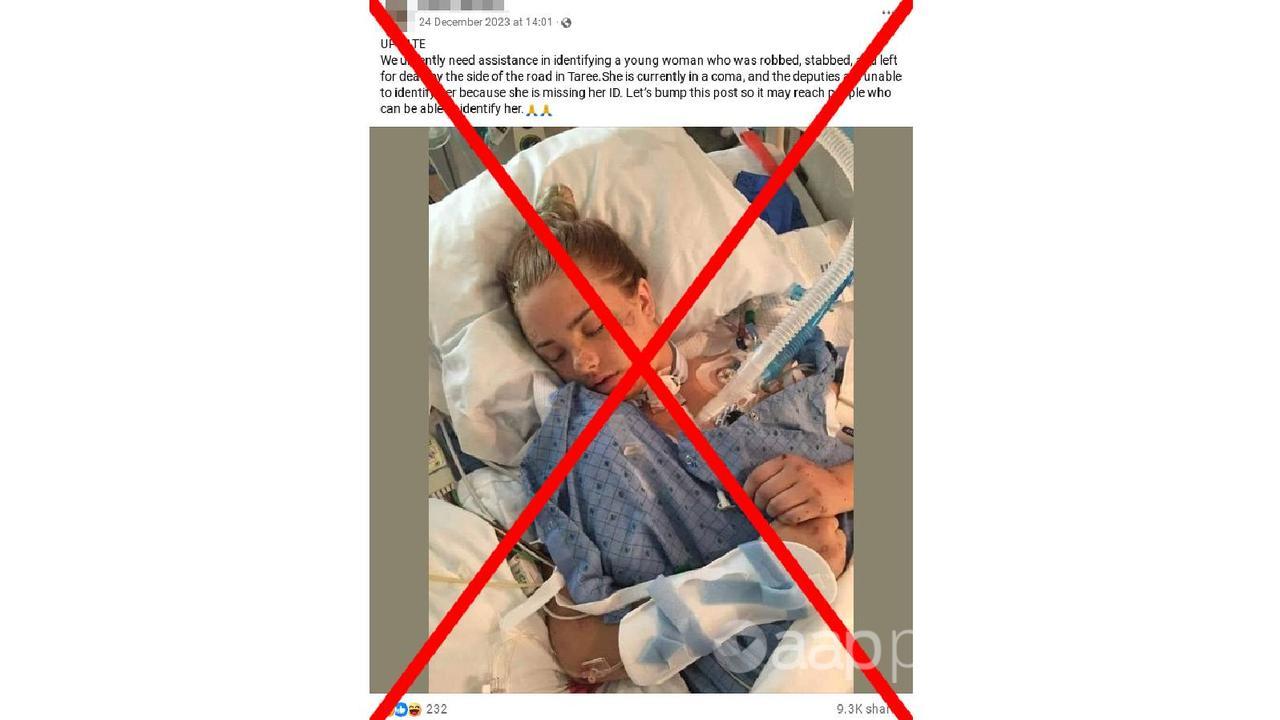It’s claimed that authorities are struggling to identify a girl who was recently robbed, stabbed, and left for dead on the side of the road in Australia.
This is false. The photo being shared in Facebook posts is of an American teenager in hospital after a 2016 car crash in Utah.
Scammers are posting her photo with the false claim and urging users to share it widely, before changing the posts to feature an advertisement with suspicious URL links.
The photo was posted (screenshot here) in a Facebook buy, sell, and swap group for “Taree to Port Macquarie”, New South Wales.

The post claims to show a young woman who has been “robbed, stabbed, and left for dead by the side of the road”.
“She is currently in a coma and the deputies are unable to identify her because she is missing her ID,” the caption reads. “Let’s bump this post so it may reach people who can be able to identify her.”
The same post has been made in several other Facebook community groups for Kingman in Arizona, Antigua in the Caribbean, Worcester in England (screenshots here, here, and here), and several other groups around the world.
However, the image does not depict a recent victim of an armed robbery. Instead, it features then-16-year-old American Taylor Carlton who was injured in a 2016 car crash. She went on to recover.
The same caption and an image were posted in a Bendigo Facebook group (screenshot here) before the author changed the caption and image, the post’s edit history shows (see here).
Scammers have also used the same caption with a different image of a hospitalised woman, examples here and here. In this case, the image has been taken from a 2016 Daily Mail story about a young woman hospitalised due to alcohol poisoning.

There are other signs that the post is a scam. The account behind it was created recently (August 2023), contains very few details, and is listed as a “Health/Beauty” page.
The comments section of the post has also been disabled to prevent savvy Facebook users from warning others it’s a scam.
The author has made identical posts in several other Facebook community groups, but with a different location in the caption, such as here, here, here, and here.
In a recent AAP report, Dan Halpin from Cybertrace, a Sydney-based cyberfraud investigations company, said that posts such as these are part of a scam called “clickbaiting” that uses emotional content to build a large audience.
After such posts are liked and shared, the images and captions are changed into ads that encourage users to click suspicious URL links.
Such scams usually feature injured pets or appeals for missing children and older people, examples here, here, here, here, here, and here.
Scammers are making thousands of Facebook posts like this that encourage people to share them and/or click nefarious links.
That means you may be tricked into a scam or advertising a scam to your family and friends on Facebook without realising it.
That’s why it’s vital to know how to spot a potential scam post.
HOW TO SPOT A SCAM POST ON FACEBOOK – THE RED FLAGS
Treat posts appealing for help to find lost or found people or pets, offering extremely cheap or free products and services with caution if they include more than one of the following features:
* The person encourages everyone to share their post widely.
* They don’t provide their contact details or they ask people to send them a DM or PM (direct message or private message).
* The post includes only very vague details about the location of the person or pet, or the giveaway.
* If the account of the person posting is less than a year old, has no profile picture, has very few friends, or isn’t located in the same area as the subject of their post. This indicates their account is fake.
* If you can’t comment on the post because the person has disabled comments. This is done to stop people from warning others that it’s a scam.
The Verdict
The claim authorities are struggling to identify a young woman who was recently robbed, stabbed, and left for dead in Australia is false.
The photo posted on Facebook is of an American teenager fighting for her life following a 2016 car crash.
It is being used as part of a clickbaiting scam intended to gain access to Facebook users’ data, money or both.
False – The claim is inaccurate.
AAP FactCheck is an accredited member of the International Fact-Checking Network. To keep up with our latest fact checks, follow us on Facebook, Twitter and Instagram.
All information, text and images included on the AAP Websites is for personal use only and may not be re-written, copied, re-sold or re-distributed, framed, linked, shared onto social media or otherwise used whether for compensation of any kind or not, unless you have the prior written permission of AAP. For more information, please refer to our standard terms and conditions.


















